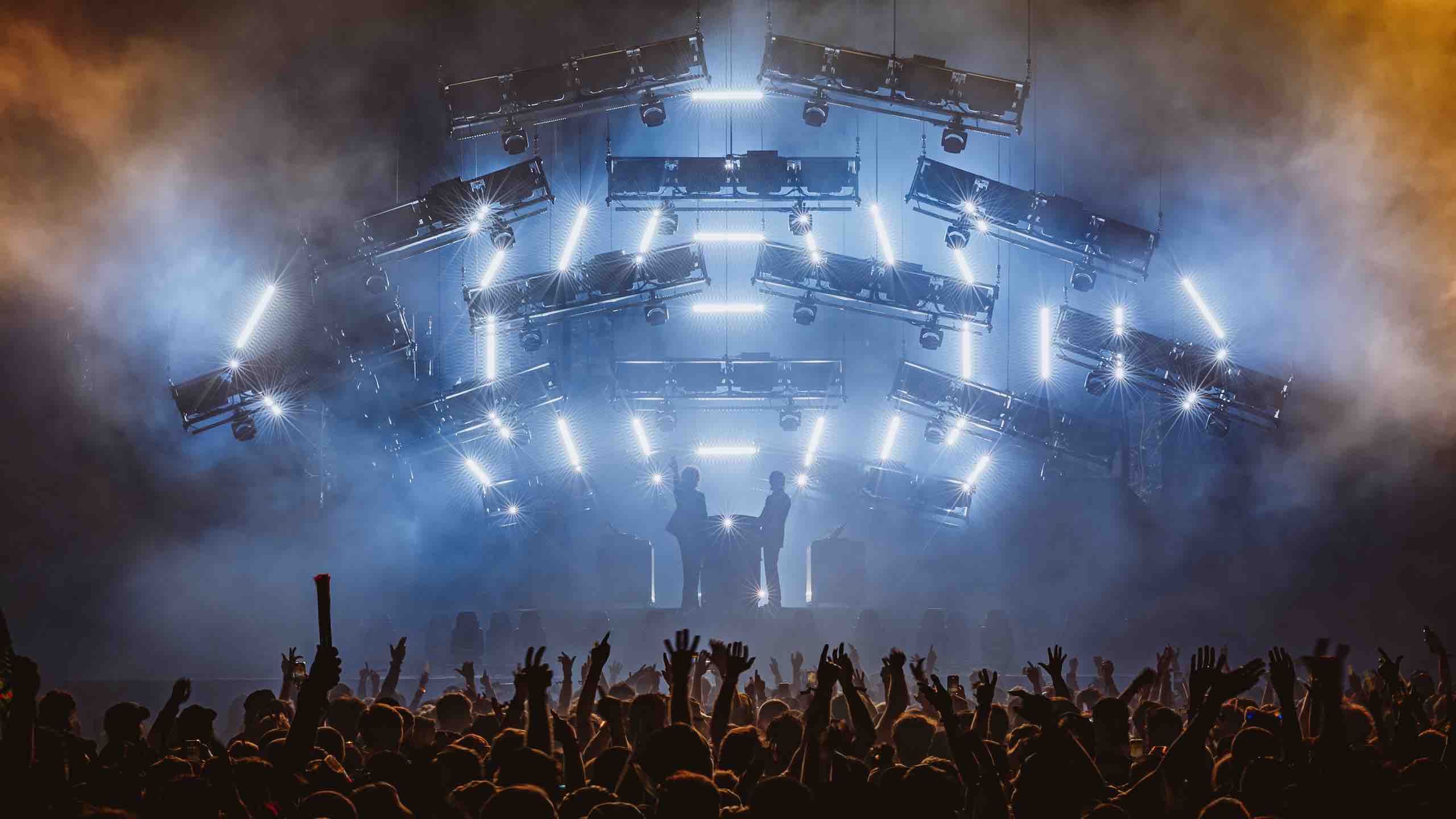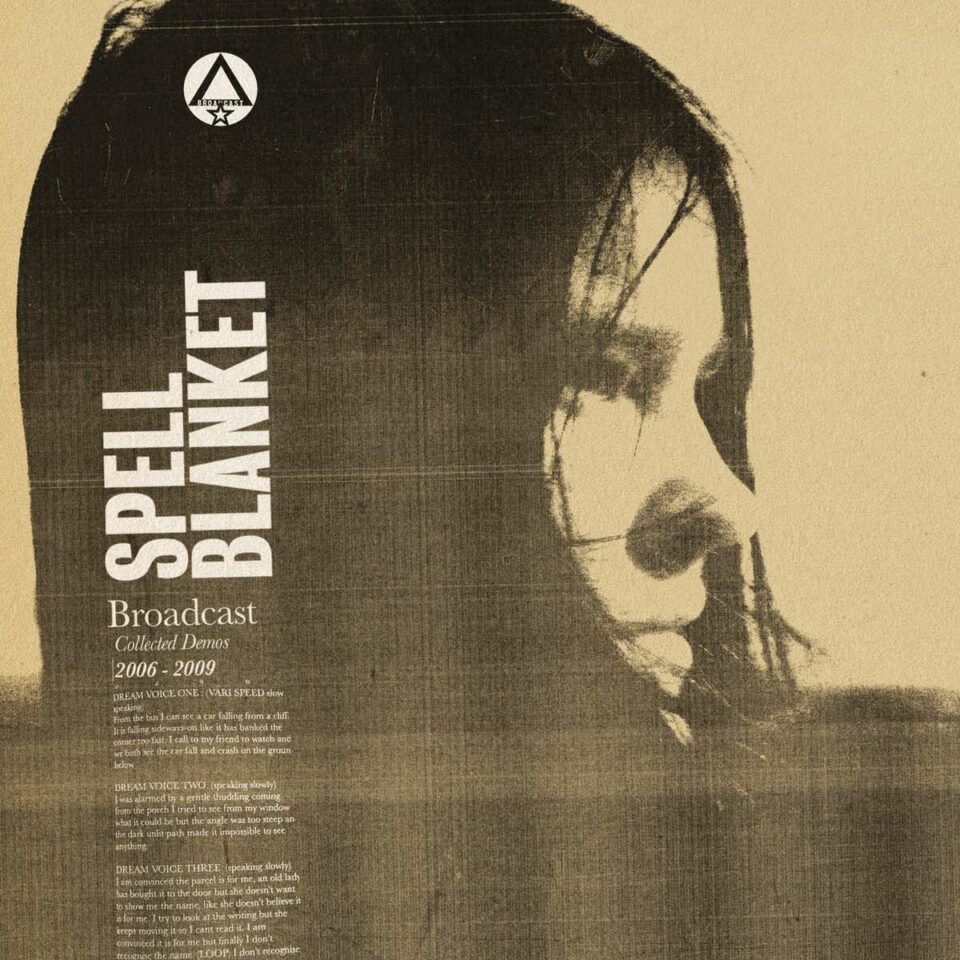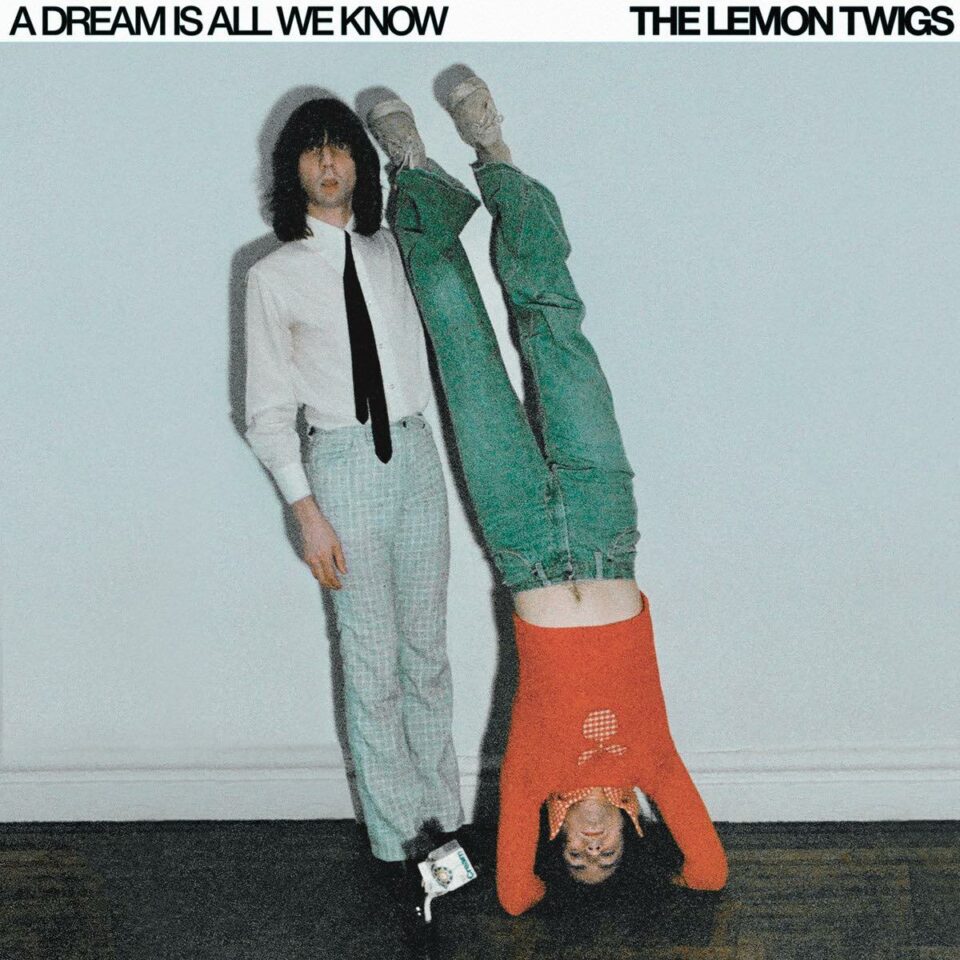It’s the Thursday before the second weekend of Coachella when I catch up with Gaspard Augé and Xavier de Rosnay of French electronic duo Justice, who have been headquartered in the desert for the past week. Augé’s voice crackles with static when he dials into our Zoom call with his camera off, as he doesn’t have a strong enough signal. This tracks with Augé’s well-documented reticence in interview participation. De Rosnay—once he’s sure that no video will be recorded—turns his camera on. He needn’t have worried. He looks extremely slick.
At first glance, it seems de Rosnay is wearing a bathrobe. A closer peer into the computer screen and it looks like a satin pajama top. But as his wonky phone camera angles provide differing perspectives, it turns out it’s a shiny cream-colored shirt, unbuttoned quite some ways down de Rosnay’s chest to reveal a gold chain necklace—one of many pieces of gold jewelry items he’s flexing. He’s serving John Travolta in that scene in Saturday Night Fever when he’s getting ready for the disco. He may be indoors, but his eyes are hidden behind black shades. He remains unsmiling throughout the interview, even when his phone has a sudden explosion of colorful balloon emojis floating up its screen.
Justice premiered the new live show for their fourth studio album, Hyperdrama, on the Friday of the first Coachella weekend. They performed the headlining slot at the Outdoor Theatre to a packed audience that was losing its collective mind. Even with this overwhelmingly positive reception, Augé and de Rosnay are on tenterhooks for their second appearance, happening in just over 24 hours. They’re heading to the polo field shortly to do a run-through of the show on-site.
The week before Coachella, they rented a venue in Las Vegas to rehearse. Prior to that, they spent six months working on the show in France, ramping up rehearsals for three weeks before their arrival in the US. This level of extended concentrated work isn’t common for the duo whose schedule typically follows a one week on, one week off regimen. Hyperdrama was created at this leisurely pace starting in June 2020, primarily in de Rosnay’s home studio in the north of Paris. “We’re very aware that freedom and the use of time is the biggest luxury we have,” says de Rosnay of Justice’s working schedule. “We started this album knowing we could spend however long we wanted on it. Of course, it can become unhealthy to spend more than 10 years on a record. But we also knew that we could organize ourselves the way we wanted. The week we work, we see each other almost every day.”
“It can become unhealthy to spend more than 10 years on a record. But we also knew that we could organize ourselves the way we wanted.” — Xavier de Rosnay
On the off weeks, the two are “living life,” according to de Rosnay, and they’re quite strict with themselves when it comes to avoiding the studio. If they have an idea, they’ll jot it down or put it in a voice memo. “It’s essential to have this time to step back and come back fresh to what you’re doing,” says de Rosnay. “Even though we’re off, we have this background task working perpetually. Even between albums, we’re constantly thinking of things we could do on another record. It never stops.”
Justice brought this mentality to Los Angeles where they worked with some marquee collaborators on Hyperdrama, namely Tame Impala, Thundercat, and Miguel. They rented a house and set up a studio in the living room. Here, they met with Parker and Thundercat to see what might transpire. Over the course of two years, they made several trips to LA for small pockets of time. “It’s impossible to force anything, especially with those guys,” says de Rosnay.
These particular collaborators were on Justice’s mind for some time—partially because the duo are fans of the music, and partially because they felt they could do something that would be natural with them. “They are, for the most part, almost like a one-person band,” de Rosnay says of all Hyperdrama’s special guests. “Even if sometimes they have collaborators for mixing or production parts, most of them are writers, composers, performers, and producers. They represent something that’s very precious to us right now in the world of music: autonomy. It’s digging your own path regardless of being trendy. They keep their specificity with time. We were as curious to make music with them and see the results as we were to actually work with them. It felt almost like being in nerd documentaries about musicians. It was instructive and it was really fun.”
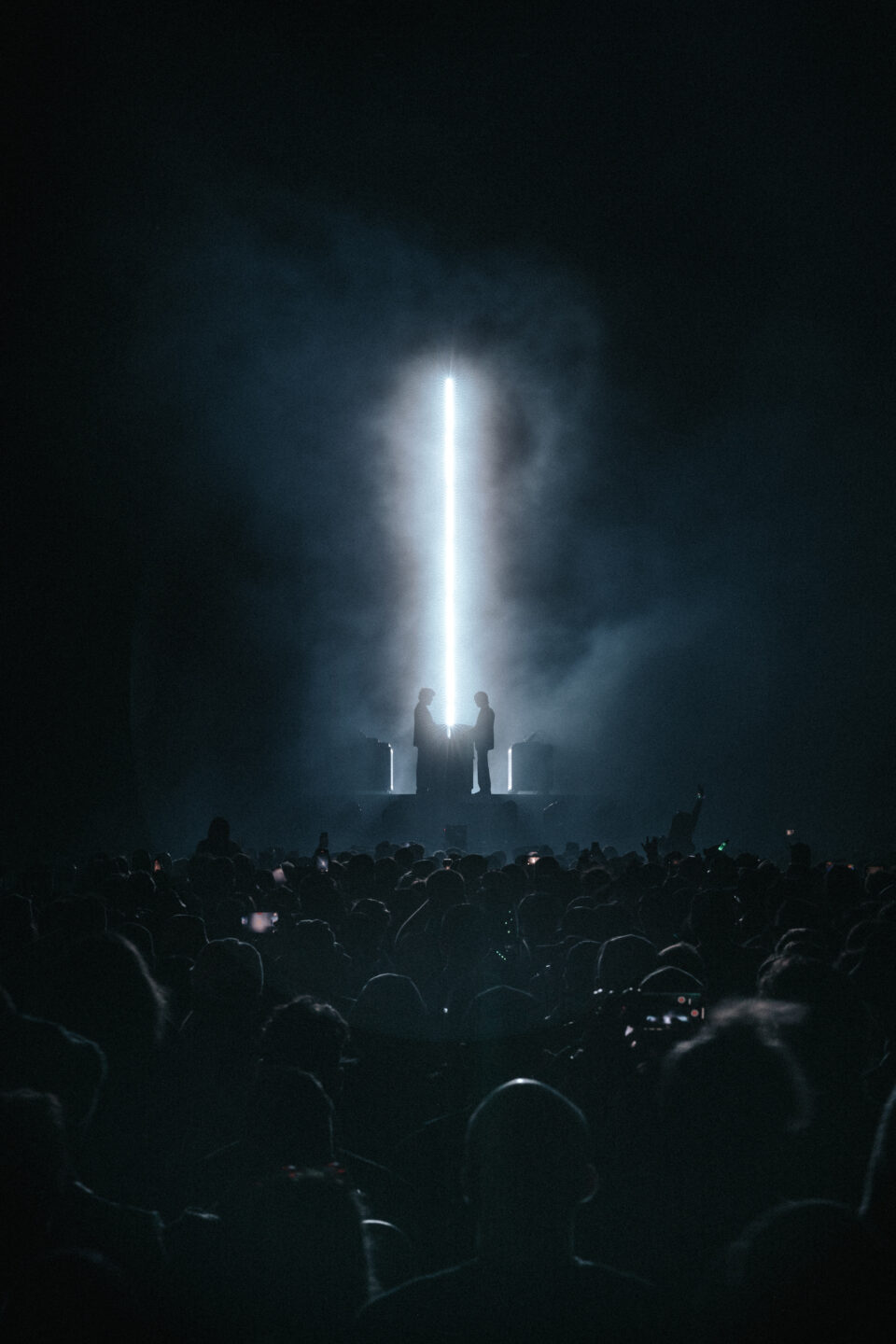
Justice / photo by Julian Bajsel
“French electronic music is probably the first time that French music got successful outside of France. I think the romanticism comes from a fascination for American and British music and trying to emulate that.” — Gaspard Augé
Unlike previous albums where Justice would mine old records for samples, for Hyperdrama, these sound sources were generated by the duo themselves. They drew inspiration from early techno, gabba, and, of course, disco records. The 13-track album has a myriad of references, including a cross section of styles from the ’80s, the decade of Augé’s and de Rosnay’s births. But it also hits some Berghain notes with “Incognito” and parts of “Generator.” “Dear Alan” and “Moonlight Rendez-vous” recall the suave sounds of the ’70s that have underscored Justice from the start.
Meanwhile, their collaborators’ stamps are apparent on the songs on which they “star,” from the psychedelic rock of Tame Impala on “One Night/All Night” to Thundercat’s frantic freeform jazz on “The End” and Connan Mockasin’s synth fever dream “Explorer.” Miguel delivers his syrupy R&B on the funk-fueled “Saturnine” while Eritrean-born neo-soul vocalist Rimon brings an airiness to “Afterimage.” Over everything, Justice brush broad strokes of rock ’n’ roll aesthetic and sexy sleaze.
Six of Hyperdrama’s songs made their live debut at Coachella Weekend One. From the crowd’s reaction, you’d think these brand-new songs were as familiar as “We Are Your Friends,” to which the entire field screamed the chorus. Coachella, one of the highest-profile festivals on the planet, is where Justice debuted their very first live show in 2007. They did that again this year. It’s a bold move to work out kinks on such a big stage. “It’s probably the most scrutinized festival on Earth, but it’s a familiar environment,” Augé says. “The production team are very loyal friends since 2007. We feel at home.”
Justice’s Coachella performances felt like they were beamed in from outer space. Their perfectly timed light shows amplified the impact of the music and dictated the increasingly heightened mood of the crowd. Amid all that, Augé and de Rosnay remained motionless, without even the slightest head nod. “Usually, at the beginning of the tour, we’re caught up in what we’re doing and too anxious to enjoy the moment.” says de Rosnay. “We blank out everything and try to focus. Everything we do, we have it in in-ear monitors. We wanted to hear everything precisely, so we had no crowd noise in our ears. It’s going to get better with time, but at the beginning we’re trying not to mess things up. The focus is taking over the will to dance and shake our heads. When we get more used to it, we can relax.”
There are key Justice identifiers that carry through each of their album eras—the light-centered live show being one, the electronically created sounds in a rock-star setting is another. The most iconic, however, is their coffin-like cross. “We stole it from Justin Bieber,” de Rosnay deadpans, then smirks for the first time during our interview. “We saw this young guy from Canada having this great idea and we said, ‘Oh shit! We need to do that!’”
De Rosnay is, of course facetiously referring to Bieber’s album title, Justice, over which the duo were embroiled in a logo trademark infringement legal battle in 2021. The origins of the Justice cross go back to their 2005 single “Waters of Nazareth,” in which they had a church organ playing mass music. To tie the religious connotations to their name, they made the “T” in Justice a cross. It also lined up with the music culture they were weaned on: Madonna’s crucifixes, George Michael’s earrings, Black Sabbath’s Headless Cross and Cross Purposes.
“It’s the Chicago method: You have your logo and you just change the texture. You go on as long as you have enough imagination to find new textures.” — Xavier de Rosnay
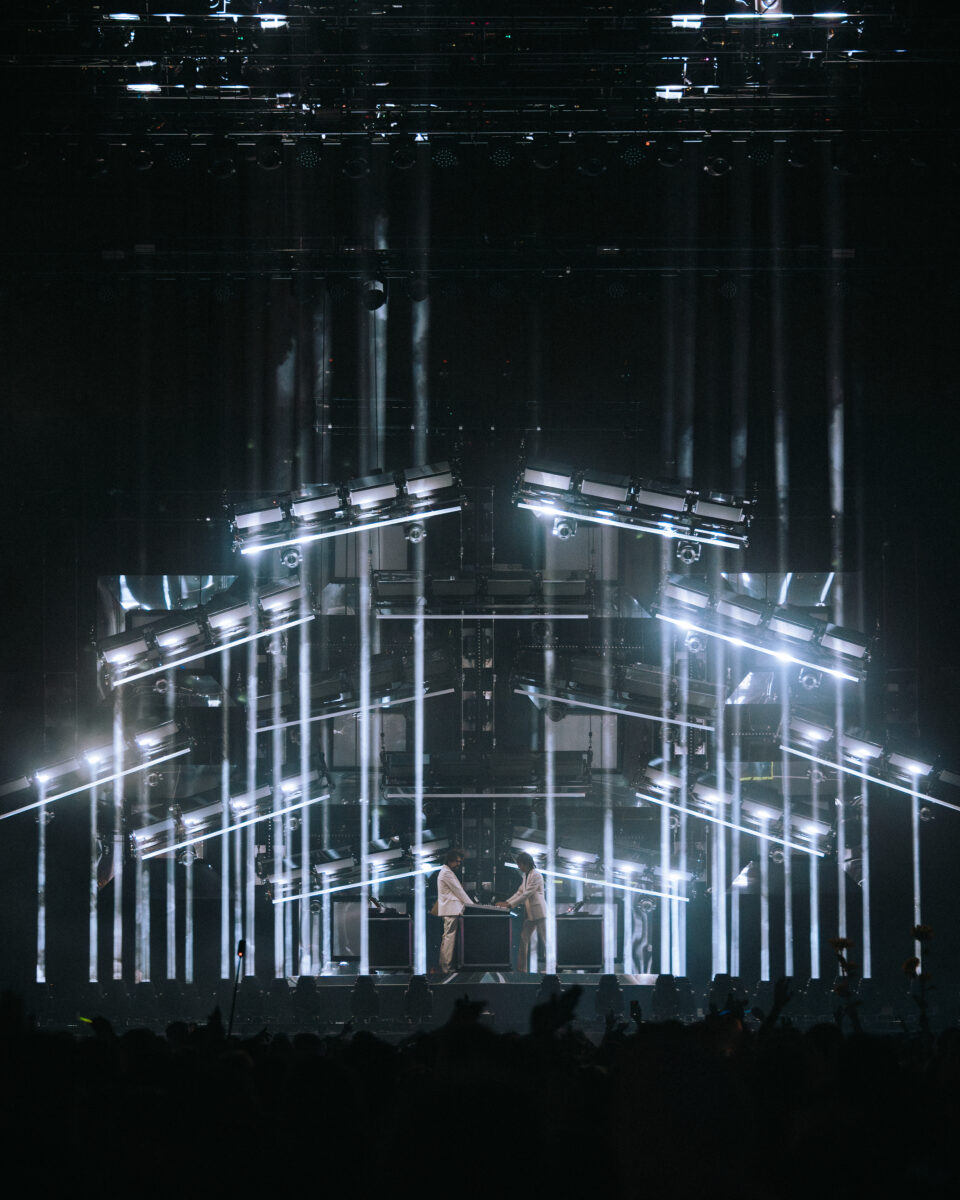
Justice / photo by Brandon Densey
“The Dark Side of the Moon was on the mantelpiece of someone’s house we were hanging at,” says de Rosnay. “We’re like, ‘If only we could have a symbol that’s so strong that we would only need to put that on the record cover. Not the band’s name, not the album’s name, just one symbol and then leave it like this. This would be perfect.’ Two weeks later, we were like, ‘Oh shit! We are so stupid. Of course we have the symbol.’ The cross is the second most identified logo type in the world after the ‘M’ from McDonald’s. It was our first album cover and became the name of our first album. Then we’re like, ‘This is too good to be left behind. Second album, third album, and so on will always be like this.’ It’s the Chicago method: You have your logo and you just change the texture. You go on as long as you have enough imagination to find new textures.”
The cross isn’t the only distinguishing characteristic that separates Justice from their French contemporaries. The duo certainly benefited from Daft Punk’s global impact and the ensuant attention that the French touch movement received, but that’s more likely due to their nationality than to their musical style. “French electronic music is probably the first time that French music got successful outside of France,” Augé points out. “I think the romanticism comes from a fascination for American and British music and trying to emulate that. But there’s something in the process that maybe makes it a bit special.”
With all Justice’s accomplishments, their outlook for Hyperdrama isn’t so far removed from where they were when they started. “We don’t have crazy commercial ambitions—never had from the beginning,” says de Rosnay. “We feel a bit like an accident. We’re still amazed that we’ve been allowed to keep on making albums and touring while doing such niche music. It doesn’t cater to everyone. That’s what we like also as listeners, viewers, readers, as an audience. We like things that are made with specificity and singularity in mind. But within that specificity and singularity we want as many people as possible to get into it, enjoy it, and get moved by it. Hyperdrama is meant to be fun, sensorial, physical, and emotional. It’s an album of pure fantasy.” FL

Justice / photo by Brandon Densey

